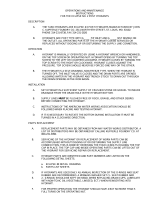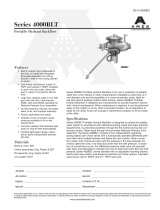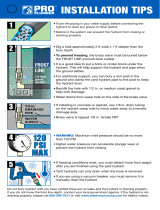Page is loading ...

5-1/4” American-Darling B-84-B-5 HydrantAMERICAN Flow Control Page 1B-10
5-1/4” AMERICAN-DARLING
®
B-84-B-5 INSTALLATION
Installation
Receiving Inspection
On receipt, inspect for direction of opening, correct
nozzle threads and operating nuts and shipping damage.
Report any problems to carrier, note on bill of
lading and have the driver sign your copy.
1.
2.
3.
4.
5.
6.
When hydrants are received, they should be handled
carefully to avoid breakage and damage to anges.
Keephydrantscloseduntiltheyareinstalled.Protect
stored hydrants from the elements.
Before installation of hydrant, clean piping, base
and drain ring of hydrant of any rocks, sand
and/or foreign material. Check for loose bolts at
base, ground line and cover. Tighten if neces-
sary.
Hydrants shall be located as shown or as directed
and in a manner to provide complete accessibil-
ity, and also in such a manner that the possibility of
damagefromvehiclesorinjurytopedestrianswillbe
minimized. Locate hydrants as detailed in AWWA M17
and/or in accordance with applicable re codes, the
requirementsoflocalreauthority,ortheapplicable
municipal design standard.
All hydrants shall stand plumb and shall have their
nozzlesparallelwithoratrightanglestothecurb,with
the pumper nozzle facing the curb, except that hy-
drantshavingtwohosenozzles90° apart shall be set
witheachnozzlefacingthecurbattheangleof45°.
Hydrants shall be set to the established grade, with
nozzlesatleast18in.abovetheground,asshownor
as directed by the engineer.
It is recommended practice to install an auxiliary
or secondary gate valve in the lateral between the
hydrant and the main to permit inspection and repair
ofthehydrantwithoutshuttingdownmains.Theuse
of AMERICAN Flow Control Series 2500 Resilient
Wedge Gate Valves are recommended.
On trac hydrants, surrounding soil must be
adequately compacted around the barrel to support
the lower barrel against transferring the force of a
vehicular impact to the base. If the soil is too sandy
and will not support the loads, pour a concrete pad
around the barrel at or near the ground line at least
6 inches thick and 36 inches in diameter for barrel
support.
This instruction is issued as a recommendation to the customer for the proper use of the AMERICAN Flow
Control manufactured re hydrants.AMERICAN recommends you follow the general Inspection and Installation guidelines
outlined in AWWA Manual M17 for Installation, Field Testing, and Maintenance of Fire Hydrants and/or as recommended
below.WARNING: Special care should be taken in the installation, inspection and repair of pressure containing devices
such as valves and hydrants. FAILURE TO FOLLOW PROPER PRACTICE AND GUIDELINES CAN RESULT IN SERIOUS
INJURY OR DEATH. High pressure and water hammer, due to rapid opening or closing of a hydrant or valve, can also
cause major damage to the hydrant, valve, water main, re hose, or other attached equipment.
Whenever a hydrant is set in soil that is
pervious, drainage shall be provided at the base of the
hydrant by placing coarse gravel or crushed stone
mixed with coarse sand, from the bottom of the
trench to at least 6 inches above the drain opening
in the hydrant and to a distance of 1 foot around
theelbow.
Whenever a hydrant is set in clay or other
impervious soil, a drainage pit 2 feet in diameter and 3
feet deep shall be excavated below each hydrant
and compactly lled with coarse gravel or crushed
stone mixed with coarse sand under and around
the elbow of the hydrant and to a level of 6 inches
above the drain opening.
Where there is a high ground water level or other
conditions which prevent the use of hydrants with
drains, “non-draining” hydrants should be used.
Hydrants of this type are provided with either a
solid seat and/or plugged drains and are marked
to pump after use. This is especially important
to avoid damage to the hydrant in areas where
freezing temperatures are likely. Non-draining
hydrants should be checked upon installation and
during semi-annual inspections to make sure the
hydrantstaysdryinsidethelowerandupperbarrel.
Restrain hydrant movement with appropriate thrust
blocking or restrained joint to prevent pipe and/or
jointseparation.Ifaconcretethrustblockisinstalled,
careshouldbetakentopreventblockingthehydrant
drains if they are to remain operable.
Whenrstinstalled,the hydrant shouldbeoperated
fromfullclosedtofullopenpositionandbacktomake
sure no obstructions are present.
After the line, as well as the hydrant, have been
hydrostaticallytested,thehydrantshould beushed
andcheckedforproperdrainage,ifapplicable.
7.
8.
9.
10.
11.
12.
/





